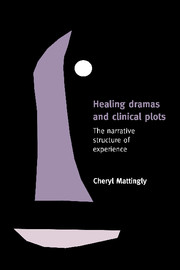Book contents
- Frontmatter
- Contents
- Preface
- Acknowledgments
- 1 Finding narrative in clinical practice
- 2 The mimetic question
- 3 The checkers game: clinical actions in quest of a narrative
- 4 Therapeutic plots
- 5 The self in narrative suspense: therapeutic plots and life stories
- 6 Some moments are more narrative than others
- 7 Therapeutic plots, healing rituals, and the creation of significant experience
- Notes
- References
- Index
6 - Some moments are more narrative than others
Published online by Cambridge University Press: 05 June 2012
- Frontmatter
- Contents
- Preface
- Acknowledgments
- 1 Finding narrative in clinical practice
- 2 The mimetic question
- 3 The checkers game: clinical actions in quest of a narrative
- 4 Therapeutic plots
- 5 The self in narrative suspense: therapeutic plots and life stories
- 6 Some moments are more narrative than others
- 7 Therapeutic plots, healing rituals, and the creation of significant experience
- Notes
- References
- Index
Summary
Although clinical interactions are always guided by some underlying narrative (some answers to the question “What story am I in?”) emplotment may be minimal and easily relinquished. Many of the narrative plots described in earlier chapters have been rich in images and clearly co-created among participants. Not all clinical time is like this. A narrative orientation to therapeutic actions is always in tension with another structure of clinical action which resists emplotment. One sees narrative interruptions – plots that begin, a story that seems to develop between therapist and patient but is subverted, and often by the therapist.
One of my first observations of occupational therapists took me by surprise as I puzzled over the odd nature of the therapist's interventions. I was struck by the therapist's willingness to abandon a group activity that, to my eyes, appeared to be highly successful. I draw from field notes and memory to tell this story. A vulnerable-looking young woman in her early twenties, a girl really, with long brown hair, sat surrounded by ten old men in their wheelchairs. She was conducting an “activities group,” she told me later. The men drooled as they listed sideways in their seats, white legged in their white dressing gowns. I watched from outside the circle, taking notes. No one seemed to notice me. Is it possible to be partly dead, I wondered? The occupational therapist had a yellow foam ball that she told them to throw to one another.
- Type
- Chapter
- Information
- Healing Dramas and Clinical PlotsThe Narrative Structure of Experience, pp. 129 - 153Publisher: Cambridge University PressPrint publication year: 1998

